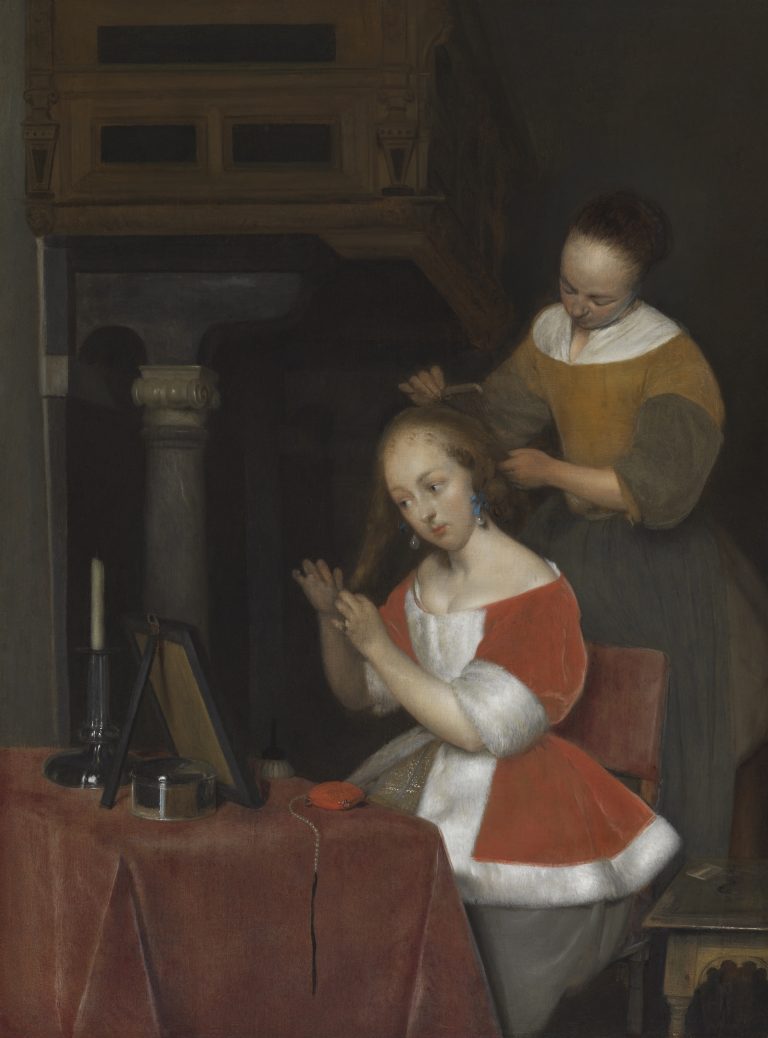In this placid vignette, a young woman fiddles with a lock of her hair as she stares pensively at her image reflected in the small mirror on the table before her. Other toilet accessories are scattered across the table: a round silver box, a candlestick, a brush, a pincushion, and a single strand of pearls. The woman’s attentive maid stands just behind, patiently pulling a comb through her mistress’s dark blond curls. In the right foreground is a low table with an ivory comb resting at one corner; filling much of the background of the scene is an ornate chimneypiece.
The subject of a woman at her toilet was one of the most popular themes in Dutch genre painting during the second half of the seventeenth century, charmingly explored on multiple occasions by artists such as Gerrit Dou (1613–75), Gabriel Metsu (1639–67), Frans van Mieris (1635–81), Caspar Netscher (1639–84), and Johannes Vermeer (1632–75) in addition to Gerard ter Borch the Younger. While some paintings draw conspicuous parallels with popular imagery and rhetoric that associated women regarding themselves in a mirror with the sins of pride and lust,1 others focus more simply on the pleasurably sensual qualities of these intimate feminine rituals. Considering Ter Borch’s life-long fascination with the quiet beauty and cherished minutiae of women’s domestic preoccupations, it is no surprise that depicting women at their toilet became one of his favored themes. Images of women primping and preening, adjusting their costume, or dressing their hair offered viewers a discreet glimpse of these private rituals. The ubiquitous presence of a maid—sometimes older, but invariably plain and soberly dressed—introduced a contrast that subtly accentuated the youthful beauty and feminine grace of the woman being dressed.
Ter Borch treated the subject of a woman dressing her hair, assisted by her maid, on at least three occasions. Each time he expressed a slightly different understanding of the event, underscoring his unique sensitivity to the minute but fascinating variations that can be found in even the most mundane, repetitive activities. Ter Borch first approached the theme in a painting of about 1650 or slightly earlier, now known only through copies.2 The composition shows a woman seated at her dressing table with a small dog in her lap. She peers at her reflected image in a mirror supported by a young boy, as she and her maid coax her long blond locks into some intricate coiffure. Woman Seated at Her Toilet incorporates most of the same elements but reverses the orientation of the figures and omits the young boy.
Woman Seated at Her Toilet is most closely related to Ter Borch’s A Lady Dressing Her Hair, of about 1657–58 in the Wallace Collection in London (fig 1). The basic compositional elements are identical in both pictures: a woman seated at a plush-covered dressing table with her maid standing just behind, and a massive marble chimneypiece in the left background. In Woman Seated at Her Toilet, the costume of the seated woman has been modified slightly and a small table was added at the lower right. The figure of the maid is no longer in profile, but turned three-quarters to the viewer, her head bent to the task of combing her mistress’s long hair. The composition has been expanded on all sides, effectively distancing the figures from the picture plane. By making this small adjustment, the artist of this work replaced the disarming intimacy of the Wallace Collection picture with a cool detachment that supports the changes he made in the figures themselves. Whereas in the Wallace Collection picture the maid seems to chatter gaily to the woman seated before her, here she seems more subservient, more distant, engaging less with her mistress and the viewer. Her downturned face masks her expression, introducing a degree of ambiguity.
Gudlaugsson described Woman Seated at Her Toilet as a relatively late work by Ter Borch, of about 1670,3 constituting a reprise of a subject that had occupied him at least a dozen years before. It seems more likely, however, that the picture is a roughly contemporary variation of the Wallace Collection’s A Lady Dressing Her Hair. The woman’s costume (specifically her red jacket) and hairstyle are more in keeping with styles of the late 1650s; furthermore, the marble chimneypiece appears in other paintings by Ter Borch of the late 1650s (including fig. 1), but not in any autograph works from around 1670. Although the elongated proportions of the figures in Woman Seated at Her Toilet—the slim ovoid heads, narrow shoulders, and attenuated limbs—are seen in a few other genre paintings ascribed to this period, for example The Duet in the Louvre, dated about 1669 (fig 2), they appear less gracefully integrated here. This weakness, as well as the simplistic modeling of the draperies and the overly sharp contours of the figures against the background, suggest that Woman Seated at Her Toilet was produced by a member of Ter Borch’s studio rather than by the master himself.
Woman Seated at Her Toilet is generally in good condition, although the dark background is somewhat worn and some pigments (notably the dark blue of the maid’s apron) appear to have deteriorated. The rather flat appearance of the woman’s red jacket may result from the loss of the thin glazes typically applied atop the paint layer to shade and model forms. On the back of the panel is a red wax collection seal, which, though fragmentary, bears an impression of a crenellated tower on a shield borne aloft by two griffins, motifs belonging to the arms of the Neufville family in the Netherlands.4 There is also a painted insignia incorporating the initials GSI, which has not yet been identified (fig 3).
